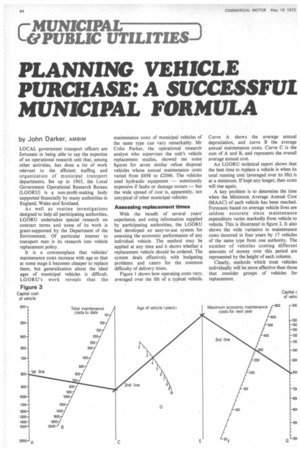C&Pu N lifirtfnunEsi
Page 66

Page 67

If you've noticed an error in this article please click here to report it so we can fix it.
PLANNING VEHICLE PURCHASE: A SUCCESSFUL MUNICIPAL FORMULA
by John Darker, AMBIM
LOCAL government transport officers are fortunate in being able to tap the expertise of an operational research unit that, among other activities, has done a lot of work relevant to the efficient, staffing and organization of municipal transport departments. Set up in 1965, the Local Government Operational Research Bureau (LGORU) is a non-profit-making body supported financially by many authorities in England, Wales and Scotland.
As well as routine investigations designed to help all participating authorities, LGORU undertakes special research on contract terms and some of its work is grant-supported by the Department of the Environment. Of particular interest to transport men is its research into vehicle replacement policy.
It is a commonplace that vehicles' maintenance costs increase with age so that at some stage it becomes cheaper to replace them, but generalization about the ideal ages of municipal vehicles is difficult. LGORU's work reveals that the maintenance costs of municipal vehicles of the same type can vary remarkably. Mr Colin Parker, the operational research analyst who supervises the unit's vehicle replacement studies, showed me some figures for seven similar refuse disposal vehicles whose annual maintenance costs varied from £698 to £2046. The vehicles used hydraulic equipment — notoriously expensive if faults or damage occurs — but the wide spread of cost is, apparently, not untypical of other municipal vehicles.
Assessing replacement times
With the benefit of several years' experience, and using information supplied by participating authorities, the LGORU had developed an easy-to-use system for assessing the economic performance of any individual vehicle. The method may be applied at any time and it shows whether a replacement vehicle should be ordered. The system deals effectively with budgeting problems and caters for the common difficulty of delivery times.
Figure 1 shows how operating costs vary. averaged over the life of a typical vehicle. Curve A shows the average annual depreciation, and curve B the average annual maintenance costs. Curve C is the sum of A and B, and represents the overall average annual cost.
An LGORU technical report shows that the best time to replace a vehicle is when its total running cost (averaged over its life) is at a minimum. If kept any longer, then costs will rise again.
A key problem is to determine the time when the Minimum Average Annual Cost (MAAC) of each vehicle has been reached. Forecasts based on average vehicle lives are seldom accurate since maintenance expenditure varies markedly from vehicle to vehicle. This is illustrated in figure 2. It also shows the wide variation in maintenance costs incurred in four years by 17 vehicles of the same type from one authority. The number of vehicles costing different amounts of money over this period are represented by the height of each column.
Clearly, methods which treat vehicles individually will be more effective than those that consider groups of vehicles for replacement.
The best way of deciding when a vehicle has reached its MAAC is by continuously assessing its performance. From maintenance costs records it is possible to calculate the maximum repair costs beyond which a vehicle ceases to operate economically.. This figure is called the "cost limit". LGORU explained in a special report the somewhat complicated effects of inflation and discounted cash flows on the calculation of the cost limit, but for transport managers the unit prepared charts, called nomograms, which enable the appropriate cost limit to be readily found.
The transport department which has maintained careful records of vehicle maintenance costs over a period of years will have no difficulty in using this valuable tool for determining vehicle replacement dates. to determine whether a particular vehicle is due for replacement, an engineer's estimate of the repair and maintenance costs in the coming year is made and compared with the cost limit. If the estimate is below the cost limit the vehicle is retained; if the estimate is above the limit, it is re placed. In marginal cases the vehicle is held back and reviewed at a later date. Every transport engineer is familiar with that situation.
The graph line chosen for a particular vehicle depends only on its depreciation rate. A typical one — of the 22 charts contained in LGORU's operating manual — is reproduced in figure 3. The only information needed to use the nomogram is the capital cost and age of the vehicle, and its total maintenance costs to date. Three lines are then drawn through the appropriate values on the scales, Scale F indicating the cost limit.
Every six months
Although the charts can be used at any time a six-monthly review period is recommended. The use of the charts assumes that preventive maintenance policies have been pursued. Obviously, if a vehicle was never serviced until mechanical failure compelled attention then the nuisance of its unreliability could well urge replacement before it appeared economically desirable.
The method should not be used for vehicles which are less than two years old.
Although comparatively rare, some vehicles may have costs which lie off some of the scales provided. If so, it is only necessary to multiply the values on the scales A, B, F, G on the replacement charts by a constant number.
The charts are prepared specifically for local government vehicles. Because the taxation basis of local government differs from that of general business, a revised nomogram allowing for business tax reliefs is called for. Mr Parker said this adjustment was relatively simple and the LGORU would consider enquiries from any companies interested in using the system.




























































































































